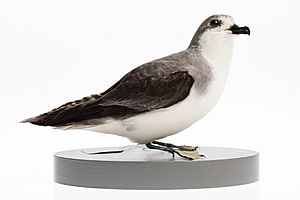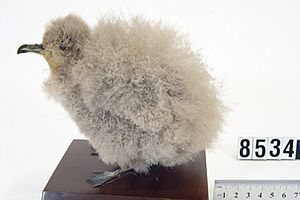Pycroft's petrel facts for kids
Quick facts for kids Pycroft's petrel |
|
|---|---|
 |
|
| Conservation status | |
| Scientific classification | |
| Genus: |
Pterodroma
|
| Species: |
pycrofti
|
The Pycroft's petrel (Pterodroma pycrofti) is a small seabird. It is part of the petrel and shearwater family, called Procellariidae.
Contents
Where Pycroft's Petrel Got Its Name
The Pycroft's petrel is a type of "gadfly petrel." These birds belong to the Pterodroma group. Scientists believe it is closely related to the Stejneger's petrel. This bird was named after Arthur Pycroft. He was a naturalist from New Zealand. He was the first to discover this species scientifically. The New Zealand scientist Robert Falla officially described the species.
What Pycroft's Petrel Looks Like
The Pycroft's petrel is a small bird. It is about 26 cm (10 in) long. It weighs between 112 and 198 grams (4 to 7 oz). Its feathers are grey and white. The top part of its body is grey. It has a darker M-shaped pattern on its back. Its belly and forehead are white. It also has a light grey band across its chest. There is a dark grey patch around its eye.
Where Pycroft's Petrel Lives
The Pycroft's petrel breeds in special places. Its breeding habitat is temperate forests. These forests have soft soils. They are found on islands located far from the mainland.
Reproduction and Life Cycle
This species only breeds in New Zealand. They nest on 11 islands off the North Island. You can find their breeding groups on Stephenson Island, the Poor Knights Islands, Hen and Chickens Islands, and Mercury Islands. They used to breed on Norfolk Island and Lord Howe Island. However, they no longer live there.
The breeding season starts in October. This is when the birds return to their nesting areas. All the birds lay their eggs around the same time. This happens between November 21 and December 10. Each pair lays only one egg in a burrow. The nesting burrows are 30 to 130 cm (12 to 51 in) long. The nesting room inside is lined with leaves. Both parents take turns sitting on the egg. The male usually takes the first turn. This first turn lasts for 10 to 14 days.
The chicks hatch about 45 days after the egg is laid. The young birds leave the nest when they are about 80 days old. They are not fed during their last week in the nest.
What Pycroft's Petrel Eats
Scientists do not know much about what this bird eats. However, it is known to eat squid and small crustaceans. Outside of the breeding season, it is thought to feed in the Central Pacific Ocean. It has been seen as far away as Japan, the United States, United States Minor Outlying Islands, and the Wallis and Futuna Islands.
Threats to Pycroft's Petrel
Sometimes, tuatara eat the chicks and eggs of the Pycroft's petrel. The species is also threatened by rats. These rats were brought to the islands by humans. They hunt and eat the eggs and young birds in the nests.
Protecting Pycroft's Petrel
The IUCN Red List says this species is vulnerable. This means it is at risk of becoming endangered. People have worked hard to remove rats and other animals that hunt these birds from their breeding islands. These efforts have helped the species recover. Its numbers are now increasing.
See also
 In Spanish: Petrel de Pycroft para niños
In Spanish: Petrel de Pycroft para niños



